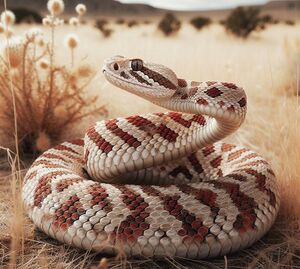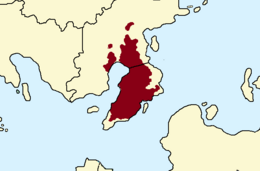Crotalus adversus: Difference between revisions
ContraViper (talk | contribs) No edit summary |
ContraViper (talk | contribs) No edit summary |
||
| Line 14: | Line 14: | ||
| subfamily = Crotalinae | | subfamily = Crotalinae | ||
| genus = Crotalus | | genus = Crotalus | ||
| species = | | species = "C. adversus" | ||
| binomial = Crotalus adversus | | binomial = Crotalus adversus | ||
| binomial_authority = Peron, 1790 | | binomial_authority = Peron, 1790 | ||
| Line 22: | Line 22: | ||
}} | }} | ||
The '''Short-faced Rattlesnake''' (''Crotalus adversus''), known locally as the "''' | The '''Short-faced Rattlesnake''' (''Crotalus adversus''), known locally as the "'''Crotaléa Caracourto'''" is a medium-sized species of pit viper found on the Guerrocan Peninsula of [[Inyursta]] and Guerroca Norte. | ||
=Habitat= | =Habitat= | ||
Revision as of 07:35, 6 January 2024
| Short-faced Rattlesnake | |
|---|---|

| |
| Scientific classification | |
| Kingdom: | Animalia
|
| Phylum: | Chordata
|
| Class: | Reptilia
|
| Order: | Squamata
|
| Family: | Viperidae
|
| Genus: | Crotalus
|
| Species: | "C. adversus"
|
| Binomial name | |
| Crotalus adversus Peron, 1790
| |

| |
| Range of Crotalus adversus | |
The Short-faced Rattlesnake (Crotalus adversus), known locally as the "Crotaléa Caracourto" is a medium-sized species of pit viper found on the Guerrocan Peninsula of Inyursta and Guerroca Norte.
Habitat
Grasslands and semi-arid habitats make up the primary selection of C. adversus. Areas which see sunlight through the "cold" season and include multiple burrows (usually rodents, but sometimes tortoises) are considered ideal habitat. Typically, this species is found utilizing lowland areas, though low-abundance populations exist at higher elevations.
Diet
The Short-faced Rattlesnake feeds primarily on rodents, however, individuals will readily take lizards in captivity and wild juveniles have been recorded consuming lizards as well.
Venom
Venom is comprised of primarily hemotoxic and cytotoxic elements. C. adversus venom contains a high number of snake-venom serineprotienases (SVSPs) which cause rapid onset hypertension in the target. In rodents, the venom leads to quick cardiac failure.
Description
Most notable due to its large eye and large pit in relation to its body, and comparatively smaller distance between the lip and upper scute of its head, factors for which it gets its common name of "Short-faced Rattlesnake". Relating to color, C. adversus is usually a pale tan or almost whitish color, with repeating terra-cotta to red chevrons which continue down the body. The tail is a dark red, almost black, with bright white banding.
Average size at maturity is usually 60-76cm SVL. Estimates of maximum adult size ranges from 95cm - 105cm, though a captive individual at the Zoo de San Parijo has been measured at 112cm.
Holotype = Male specimen, 80cm TL, 71cm SVL, collected approximately 1.3km east of San Miguel by a rancher in 1788 and formally described by Peron in 1790.